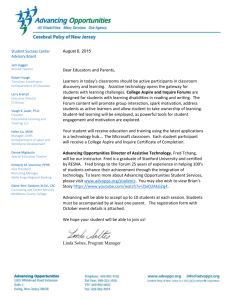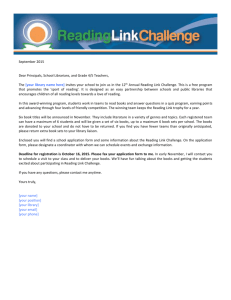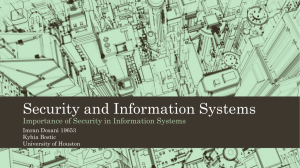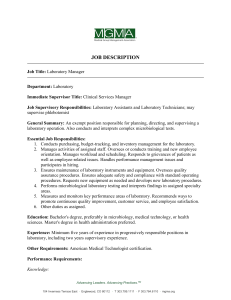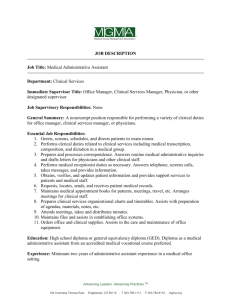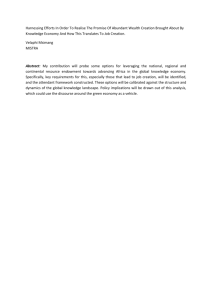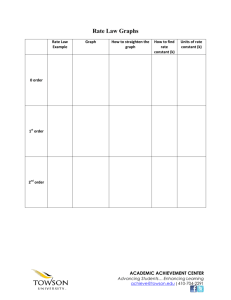Math and RtI FINAL PPT NOV 30 LATEST VERSION
advertisement
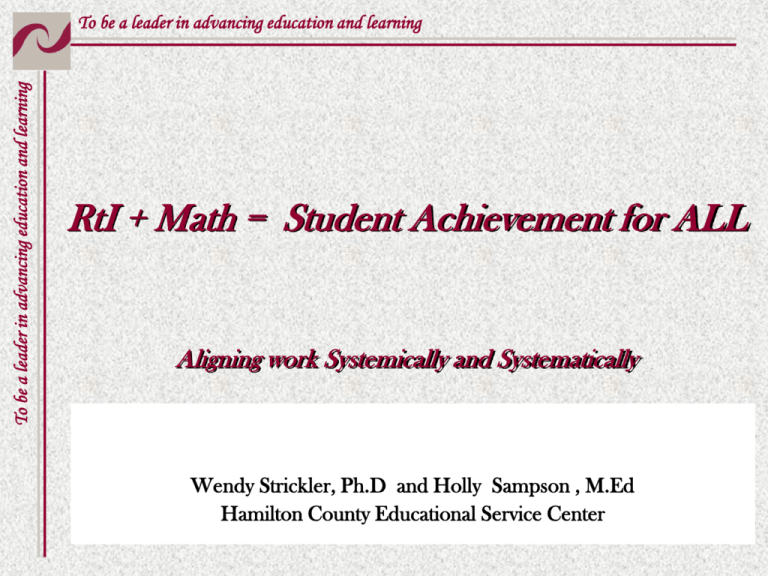
To be a leader in advancing education and learning To be a leader in advancing education and learning RtI + Math = Student Achievement for ALL Aligning work Systemically and Systematically Wendy Strickler, Ph.D and Holly Sampson , M.Ed Hamilton County Educational Service Center To be a leader in advancing education and learning To be a leader in advancing education and learning Logistics To be a leader in advancing education and learning To be a leader in advancing education and learning Mathematics = ALL Students Why do we care? Do you know… According to recent survey data, What percent of the US population are unable to calculate a 10% tip on a lunch? To be a leader in advancing education and learning To be a leader in advancing education and learning What percent of eighth-graders can not correctly shade 1/3 of a rectangle? To be a leader in advancing education and learning To be a leader in advancing education and learning What percent can not solve a word problem that required dividing fractions? To be a leader in advancing education and learning To be a leader in advancing education and learning Here’s a little help… 27% 58% 45% To be a leader in advancing education and learning To be a leader in advancing education and learning Answers *58%- Tip *27%- Rectangle *45%- Fractions in Problem Solving Student Exhibiting Mastery in Algebra Readiness Components Category Entering Math Tech 1 Entering Algebra 1 Fractions and their Applications 3.6% 44.8% Decimals their Operations and Applications: Percent 13.1% 66.7% Measurement of Geometrical Objects 23.8% 58.3% Graphical Representation 15.5% 61.5% Integers their Operations & Applications 32.1% 86.5% Total number of students per course 84 96 To be a leader in advancing education and learning To be a leader in advancing education and learning Overall Objectives Learn and discuss components of curriculum, instruction and assessments necessary for tiered intervention support. Review and further understand the systems within the schools/district we work to further enhance the support to our students. Engage participants in an examination of effective mathematic instructional strategies and begin sharing possible resources for interventions and best practices in mathematics instruction. To be a leader in advancing education and learning To be a leader in advancing education and learning Quick Math Try this: 101 - 102 = 1 Make one move to create a true statement. To be a leader in advancing education and learning To be a leader in advancing education and learning 101 =102 - 1 101- 10²= 1 To be a leader in advancing education and learning To be a leader in advancing education and learning There’s more than one way to skin a cat… Important to acknowledge how individual students work and to continue to build on what we know so we can help students make gains. Working systemically and systematically can help us achieve this. Systemic / Systematic ??? Systemic / Systematic To be a leader in advancing education and learning To be a leader in advancing education and learning Turn and Talk What systems are in place within your district/school/team to support mathematics? An Integrated Systems Approach… RtI- Response to Intervention Academic Systems 1-5% Intensive Individualized Interventions 5-10% Targeted Interventions 80-90% School-Wide Interventions Adapted from OSEP Effective School-Wide Interventions Behavioral Systems 1-5% Intensive Individualized Interventions 5-10% Targeted Interventions 80-90% School-Wide Interventions Decisions about tiers of support are data-based To be a leader in advancing education and learning To be a leader in advancing education and learning Academic Systems 1-5% Intensive Individualized Interventions 5-10% Targeted Interventions 80-90% School-Wide Interventions To be a leader in advancing education and learning To be a leader in advancing education and learning 3 Tiers of Support Tier 1: Core standards-based mathematics curriculum for all students grounded in scientifically-based research. Tier 2: Targeted or secondary resources and/or processes to address the skills of students who need further interventions supplemental to their core mathematics instruction. Tier 3: Individualized support designed for students who need intensive math skill support when provided with primary and secondary intervention. Adapted from: RTI- Response to Intervention pamphlet, HCESC To be a leader in advancing education and learning To be a leader in advancing education and learning Tier 1- The Core Curriculum Instruction Assessment To be a leader in advancing education and learning To be a leader in advancing education and learning Tier 1-The Core Key Characteristics All students receive this instruction Research-validated core curriculum Instructional gaps filled with supplemental research-based materials Differentiated support To be a leader in advancing education and learning To be a leader in advancing education and learning The Core: Math Curriculum A Balanced Approach Number sense Computation fluency Algebraic thinking Math language To be a leader in advancing education and learning To be a leader in advancing education and learning Source: Ohio Department of Education Mathematics Content Standards, 2001 Ohio Standards NCTM Standards Number, Number Sense and Operations Standard Students demonstrate number sense, including an understanding of number systems and operations and how they relate to one another. Students compute fluently and make reasonable estimates using paper and pencil, technology supported and mental methods. Number and Operations Standard • Understand numbers, ways of representing numbers, relationships among numbers, and number systems; • Understand meanings of operations and how they relate to one another; and • compute fluently and make reasonable estimates. To be a leader in advancing education and learning To be a leader in advancing education and learning Ohio Standards NCTM Standards Measurement Standard Students estimate and measure to a required degree of accuracy and precision by selecting and using appropriate units, tools and technologies. Measurement Standard • Understand measurable attributes of objects and the units, systems, and processes of measurement; and • Apply appropriate techniques, tools, and formulas to determine measurements. To be a leader in advancing education and learning To be a leader in advancing education and learning Ohio Standards NCTM Standards Geometry and Spatial Sense Standard Students identify, classify, compare and analyze characteristics, properties and relationships of one-, two- and threedimensional geometric figures and objects. Students use spatial reasoning, properties of geometric objects, and transformations to analyze mathematical situations and solve problems. Geometry Standard • Analyze characteristics and properties of two- and three-dimensional geometric shapes and develop mathematical arguments about geometric relationships; • Specify locations and describe spatial relationships using coordinate geometry and other representational systems; • Apply transformations and use symmetry to analyze mathematical situations; and • Use visualization, spatial reasoning, and geometric modeling to solve problems. To be a leader in advancing education and learning To be a leader in advancing education and learning Ohio Standards NCTM Standards Patterns, Functions and Algebra Standard Students use patterns, relations and functions to model, represent and analyze problem situations that involve variable quantities. Students analyze, model and solve problems using various representations such as tables, graphs and equations. Algebra Standard • Understand patterns, relations, and functions; represent and analyze mathematical situations and structures using algebraic symbols; and • Use mathematical models to represent and understand quantitative relationships; analyze change in various contexts. To be a leader in advancing education and learning To be a leader in advancing education and learning Ohio Standards NCTM Standards Data Analysis and Probability Standard Students pose questions and collect, organize, represent, interpret and analyze data to answer those questions. Students develop and evaluate inferences, predictions and arguments that are based on data. Data Analysis and Probability Standard • Formulate questions that can be addressed with data and collect, organize, and display relevant data to answer them; • Select and use appropriate statistical methods to analyze data; • Develop and evaluate inferences and predictions that are based on data; and • Understand and apply basic concepts of probability. To be a leader in advancing education and learning To be a leader in advancing education and learning Ohio Standards NCTM Standards Mathematical Processes Standard Students use mathematical processes and knowledge to solve problems. Students apply problem-solving and decision-making techniques, and communicate mathematical ideas. Problem Solving Standard Reasoning and Proof Standard Communication Standard Connections Standard Representation Standard To be a leader in advancing education and learning To be a leader in advancing education and learning Tier 1: Math Core Curriculum Checking the Research Base Try: What Works Clearinghouse: http://ies.ed.gov/ncee/WWC/ Johns Hopkins Best Evidence Encyclopedia: www.bestevidence.org To be a leader in advancing education and learning To be a leader in advancing education and learning Quick Math The answer is 42. What is the question? To be a leader in advancing education and learning To be a leader in advancing education and learning Tier 1 – The Core: Math Instruction Explicit instruction Pre-skills are taught to mastery Strategies, including problem-solving and graphic organizers To be a leader in advancing education and learning To be a leader in advancing education and learning Tier 1 – The Core: Math Instruction Concrete-representational-abstract sequence Authentic contexts Multiple opportunities to practice with guidance and feedback To be a leader in advancing education and learning To be a leader in advancing education and learning The Core: Instruction Communication Continuous progress monitoring Cooperative learning such as peer tutoring To be a leader in advancing education and learning To be a leader in advancing education and learning Recap of the Big “9” Instruction at the “Core” Explicit instruction Pre-skills are taught to mastery Strategies, including problem-solving and graphic organizers Concrete-representational-abstract sequence Authentic contexts Multiple opportunities to practice with guidance and feedback Communication Continuous progress monitoring Cooperative learning such as peer tutoring To be a leader in advancing education and learning To be a leader in advancing education and learning Video 1 Good Morning Miss Toliver Table Talk “Round and Round” To be a leader in advancing education and learning To be a leader in advancing education and learning Take a Break.. 10 minutes How do we acquire the information necessary to make instructional decisions for our students? Assessment What question are we trying to answer? Purposes of Assessment SCREENING DIAGNOSTIC School-wide Individual student Broad index Specific academic domains Yearly / 3x / Monthly As needed Determine health of system, ID at-risk ID specific student deficits System focus Student focus Class / school instruction and curriculum decisions 1st step for instructional planning Selecting curriculum and instructional methods Planning or specifying interventions Purpose of Assessment PROGRESS MONITORING EVALUATION Class / small group / student School wide Specific academic skills or behavioral targets Broad index <3 wks / weekly / daily Yearly (or more frequently as needed) Monitor, regroup students Determine program needs Student focus System focus Intervention effectiveness Class / school instruction and curriculum decisions Continue or revise support Core and intervention planning / revising What Question are we trying to answer within an RtI Framework? Tier Questions Tier 1 How healthy is our overall system (district/school/grade/class)? Which students should be targeted for additional support/instruction/enrichment? Are students progressing at expected rates? Are our students progressing at expected rates? Closing achievement/behavior gaps? Meeting expected benchmarks? Tier 2 Tier 3 Types of assessment Universal screener Universal screener Progress Monitoring More frequent progress monitoring; Diagnostic tests; others Examples Aimsweb, CBM, OGT Aimsweb, CBM, YearlyProgressPro, OGT Aimsweb, CBM, YearlyProgressPro, Diagnostic measures, OGT *On-going assessments (e.g. formative, mastery, short-cycle, and informal assessments) are part of all 3 tiers and used in meaningful ways Tier 1 Assessment Universal Screening Connected to key academic content or behavior Conducted at least 3 times per year on a regular basis, using comparable test forms Administered school wide to all students Used to determine if additional examination is warranted Features: short, few items, focus on critical indicators Tier 1 Assessment 2 Critical Pieces of Information Is the Tier 1 core effective? For all students (aggregated)? For each subgroup of students (disaggregated)? Who are the ~20% of students needing additional support? Tier 1-The Core: Math Assessment Math Universal Screeners 4 considerations (Fuchs, 2006) Feasible to implement Strong predictor of high stakes tests Developmentally appropriate Accurate cut-score for determining need for additional support (note: because assessment impacts instruction, make sure there is balance) Tier 1-The Core: Math Assessment Universal Screening Possible areas of focus: Number Sense and Computation Fluency Measurement Geometry Patterns, Functions, algebra Data Analysis and Probability Problem Solving Tier 1: Math Assessment Universal Screening Possible resources: Aimsweb Yearly ProgressPro Intervention Central (Numberfly, Math Worksheet Generator) Using Curriculum Based Measurement for Progress Monitoring in Math, 2007 (Fuchs, Fuchs, and colleagues) Tier 1: Math Assessment Decision Rules Deno & Mirkin Instructional Mastery criteria Grades 1-3: 20+ digits correct per minute Grades 4-6: 40+ digits correct per minute AIMSweb norms Support lowest 25% of class/grade Ongoing Research In This Area Important to collect data; if all students struggling with skill should have mastered based on ODE, need Tier 1 instruction To be a leader in advancing education and learning To be a leader in advancing education and learning Tier 1: Math Assessment Curriculum-Based Assessment (CBA) Creating your own tools Sample grade-level screening tools CBA Example Kindergarten Number and Operations 3 Questions For Each Indicator = Draw 5 dots Which is bigger: 7 2 Fill in the blank: 2 3 __ 5 Count backward 10 1 CBA Example for High School 3 questions for each indicator Number sense: Identify subsets of the real number system 1) Which number is an irrational number? A) -2 8 B) C) 3 22/8 To be a leader in advancing education and learning To be a leader in advancing education and learning Turn and Talk Based on your grade level, discuss a keystone skill that all students need to master. How might a CBM look? To be a leader in advancing education and learning To be a leader in advancing education and learning Video 2 Secondary Example Connecting Knowledge www.PD360.com Support- Tier 1-The CORE 4 Key Characteristics Curriculum/Resources Instruction What system is in place to support the work at Tier 1? What initial or additional supports need to be in place to support the Core- Tier 1? How does this look in other schools within your district (or other districts)? Assessment To be a leader in advancing education and learning To be a leader in advancing education and learning Levels of Support Chart Describe “The Core” within your classroom/ school/district. What system is in place to support the work at this level? What initial or additional supports need to be in place to support the Core-Tier 1? How does this look in other schools within your district (or other districts)? To be a leader in advancing education and learning To be a leader in advancing education and learning Tier 1-The Core Key Characteristics All Students receive this instruction Research-Validated Core Curriculum Instructional Gaps filled with Supplemental Research-based Materials Differentiated Support Support - Tier 2- Targeted Instruction 3 Key Characteristics- Resources Instruction What system is in place to support the work at Tier 2? What initial or additional supports need to be in place to support tier 2? How does this look in other schools within your district (or other districts)? Assessment To be a leader in advancing education and learning To be a leader in advancing education and learning Tier 2 Targeted Supports Key Characteristics: Small group or individual instruction in addition to the core Research-based strategies/interventions Regular progress monitoring for efficient changes as needed To be a leader in advancing education and learning To be a leader in advancing education and learning Tier 2 : Math Support Focused Targets: Number Sense Fluency in Computation Algebraic Skills To be a leader in advancing education and learning To be a leader in advancing education and learning Tier 2 : Math Support Tiered Interventions in Development PALS for Math (Peer-Assisted Learning Strategies) (Fuchs, Fuchs & Karns, 2001) 3-Tier Math Intervention for Grades K-2 (Bryant & Bryant, 2007; focus on number sense and basic skill knowledge and application) Developing Algebraic Literacy (K-3) (D. Allsopp and colleagues) To be a leader in advancing education and learning To be a leader in advancing education and learning Tier 2 Math Support Problematic Skills Language of Math Word Problems Multi-step Problems Bryant To be a leader in advancing education and learning To be a leader in advancing education and learning Tier 2 Math Support: Instruction Increased support and explicitness Increased modeling Increased opportunities for guided instruction Corrective feedback (More opportunities) Explicit and Systematic Instruction Model: Provide explicit examples of new material. Practice: Provide ample opportunities for students to practice new material. Ample is defined by the individual needs of each student. Assess (ongoing): Check students’ understanding of the new material throughout the lesson. Feedback: Immediately correct any incorrect student responses by repeating the teacher 63 model. To be a leader in advancing education and learning To be a leader in advancing education and learning Explicit Instruction Break down the skills into manageable and deliberately sequenced steps. Provide overt instruction in the skills and opportunities to practice (Roshenshine & Stevens, 1986). 2008 Step by step manner Clear and detailed explanations Mastery of each step is assured before moving on to the next Futures Task Force on Academic Outcomes 64 To be a leader in advancing education and learning To be a leader in advancing education and learning Explicit Instruction Modeled, Guided, and Independent Practice “I do” (presentation of materials), “we do” (guided practice), “you do” (independent practice). Feedback and Ongoing Assessment Uses a high number of teacher questions and student responses with frequent checks for understanding. Sample Intervention Increased Explicit Instruction Steps: 1: Teacher selects problems from student work that warrant explicit instruction, 2: Teacher demonstrates how to perform the algorithm “thinking aloud” the steps, 3: Students imitate the process on similar problems, 4: A completed model remains as a referent on the student’s paper as a permanent. (Rivera & Smith, 1987; 1988; Bryant, Hartman, & Kim, 2003) To be a leader in advancing education and learning To be a leader in advancing education and learning 3rd grade OAT Math Released (Spring 2008) To be a leader in advancing education and learning To be a leader in advancing education and learning Quick Math BUDDY UP!!! 4th grade OAT Math Released (Spring 2008) 4th grade OAT Math Released (Spring 2008) OGT Example Spring 2006 Question 4 Standard: NNS Benchmark: G. Estimate, compute and solve problems involving real numbers, including ratio, proportion and percent, and explain solutions. Adam was going to buy a new lawn mower from Lawn Care Depot for $169, less a 10% discount. He saw the same mower on sale at Tractors-R-Us. Their mower originally cost $210 and was on sale 1 for 3 off. Determine the sale price of the mower at each store. Show your work or provide an explanation to support your answer. Identify which store would be the most economical place to purchase the mower. (2 points) Points Student Response 2 The focus of the item is to calculate discounts of original prices. The response states that the sale price of the lawnmower at Lawn Care Depot is $152.10 and the sale price at Tractors-R-Us is $140. The student identifies Tractors-R-Us as the most economical place to purchase the mower. 1 The response provides evidence of a partially correct answer and/or solution process. The response shows understanding of some key elements of the task but contains gaps or flaws. 0 The response indicates inadequate understanding of the task. To be a leader in advancing education and learning To be a leader in advancing education and learning Lunch List of suggested places on back table… To be a leader in advancing education and learning To be a leader in advancing education and learning Tier 2 Math Support: NCTM recommends 5 processes for strugglers: Communication Problem solving Reasoning/proof Connections (graphic organizer) Representations (draw, diagram) Process Articles and Jigsaw Discussion Small group • Each person chooses one of the articles to read and capture important points of interest. Fill in “Process Standards in A NUTSHELL” Sheet Each person take turns sharing out important aspects of their article. Fill in the sheet provided. • • Process Standards in a Nutshell Communication Problem solving Reasoning/proof RtI Assessments Tier 1: Universal Screening Tier 2: Tier 3: Progress Monitoring (Keystone Skill) and additional information -More frequent progress monitoring -More assessments based upon individualized needs (e.g. prerequisite skills, diagnostics) *On-going assessments (e.g. formative, mastery, short-cycle, and informal assessments) are part of all 3 tiers and used in meaningful ways Tier 2: Math Assessment Progress Monitoring-current focus mostly fluency Aimsweb Yearly ProgressPro Intervention Central (Numberfly, Math Worksheet Generator) Using Curriculum Based Measurement for Progress Monitoring in Math, 2007 (Fuchs, Fuchs, and colleagues) To be a leader in advancing education and learning To be a leader in advancing education and learning Tier 2: Math Assessment Decision Rules Fuchs and Fuchs (2009) recommendations CBM end levels (after 10-20 weeks of Tier 2 tutoring) Slope of student’s progress “typical” end-of-year benchmarks To be a leader in advancing education and learning To be a leader in advancing education and learning Tier 2: Math Assessment Curriculum-Based Assessment If progress monitoring probes are not available, can you create a measure of progress monitoring? CBA Example: 6th grade Algebra 3 questions for each indicator Write math equation Six people are bringing 12 cupcakes each to a party. How many cupcakes will be at the party? Solve these equations 150/3= Write a word problem for these equations Write an equivalent formula 12 / 4 2(L + W) = 2L + 2W Write the formula Input Output 1 3 2 6 3 9 To be a leader in advancing education and learning To be a leader in advancing education and learning Chart Describe the Tier 2 interventions within your classroom/ school. What system is in place to support the work at Tier 2? What initial or additional supports need to be in place to support Tier 2? How does this look in other schools within your district (or other districts)? Support- Tier 2 – Targeted Instruction 3 Key Characteristics Resources Instruction What system is in place to support the work at Tier 2? What initial or additional supports need to be in place to support tier 2? How does this look in other schools within your district (or other districts)? Assessment Tier 3: Individualized Instruction Key Characteristics: Small group or individualized instruction in addition to the core Research-based strategies/interventions Individualized to students needs based on collaborative problem solving Frequent progress monitoring To be a leader in advancing education and learning To be a leader in advancing education and learning Tier 3: Individualized Instruction Curriculum Content should align with core curriculum to which student still has access Content should fill in gaps in knowledge/skills as determined through further diagnostics Tier 3: Individualized Instruction Focused targets: **Fractions and other concepts relating to rational numbers Fluency with standard algorithms Commutative, Associative, Distributive laws Translation of word problems into symbols Basic measurement concepts To be a leader in advancing education and learning To be a leader in advancing education and learning Tier 3: Individualized Instruction Instructional strategies: Increased opportunities for direct instruction, practice, and feedback Re-teaching skills not yet mastered Using visuals and verbalization Teaching metacognitive strategies Critical Components of Effective Instruction for Students Struggling in Math Instructional Component Explicit Instruction (n=11) Multiple heuristics (n=4) Verbalizations (n=8) Visuals for teacher and student (n=7) Visuals for teacher only (n=5) Visuals combined (n=12) Range and Sequence of examples (n=9) Teacher feedback (n=7) Teacher feedback with recommendations (n=3) Teacher feedback combined (n=10) Student feedback (n=7) Student feedback with goals (n=5) Student feedback combined (n=12) Cross-age tutoring (n=2) Within class peer-assisted learning (n=6) Random Effects Mean 1.22 1.56 1.04 0.54 0.41 0.47 0.82 0.21 0.34 0.23 0.23 0.13 0.21 1.02 0.12 Gersten, R., Chard, D., Jayanthi, M., Baker, S., Morphy, P., & Flojo, J. (2008). Mathematics Instruction for Students with Learning Disabilities or Difficulty Learning Mathematics: A synthesis of the intervention research. Portsmouth, NH: RMC Research Corporation, Center on Instruction To be a leader in advancing education and learning To be a leader in advancing education and learning Tier 3: Individualized Instruction Assessment Curriculum Based Assessment to specify skills and needs Additional diagnostics Frequent monitoring of progress To be a leader in advancing education and learning To be a leader in advancing education and learning Tier 3 Each student participating in Tier 3 should have a collaborativelydeveloped written plan outlining: Intervention plan and logistics Assessment plan and logistics Goals Support- Tier 3 – Individualized Instruction 4 Key Characteristics Resources Instruction What system is in place to support the work at Tier 2? What initial or additional supports need to be in place to support tier 2? How does this look in other schools within your district (or other districts)? Assessment To be a leader in advancing education and learning To be a leader in advancing education and learning Ideas for Supporting Learning To be a leader in advancing education and learning To be a leader in advancing education and learning I Forget….. Forgetting happens very quickly… 47% of forgetting occurs in the first 20 min. 62% of forgetting occurs in the first day. 82% of forgetting occurs in the first 3 weeks. Forgetting slows down after 2 weeks….. But then, there is not much left to forget. Therefore, the prime time to process, discuss and reflect is immediately after new information is presented ---- before the forgetting begins. Source: Instruction for All by Paula Rutherford What Math Students Need Across the Tiers Focused Targets 1. 2. 3. Langua Numb Computa ge of er tion Math Sense Fluency Vocabul ary and Writing 4. Word Proble ms Strategy/ Activity/ Other Building background / providing relevance Quick Math Turn and Talk Models 5. Algebraic skills (Including fractions and all rational numbers) Process Standards 6. 7. 8. 9. 10. 11. Multi- Geometry Reasoni Representa Communic Connectio step and ng/ tions ation ns proble Measurem Proof (draw, (graphic ms ent diagram) organizer) Brief Description Need(s) Addressed (see list above) 12. Problem Solving Application: How has it been used/could it be used To be a leader in advancing education and learning To be a leader in advancing education and learning Students With Math Difficulties… Struggle with Math Language Problem Solving Computational Fluency To be a leader in advancing education and learning To be a leader in advancing education and learning Students with math difficulties… Struggle with Math Language To be a leader in advancing education and learning To be a leader in advancing education and learning Strategies Vocabulary - Frayer Model - Marzano’s 6 Steps Journaling Talk Moves (Prime - Even - Percent ) Choose one of the mathematical words above. (Don’t tell anyone your choice. Don’t write it on your paper) Fill in the outer boxes to help explain your word. Be ready to share your information to your group. To be a leader in advancing education and learning To be a leader in advancing education and learning ? To be a leader in advancing education and learning To be a leader in advancing education and learning Share Why is teaching vocabulary important? Why We Should Teach Vocabulary • • • • • Learning is fundamentally and profoundly dependent on vocabulary knowledge. Vocabulary knowledge is highly correlated with overall reading/math achievement. Vocabulary deficiencies are a primary cause of academic failure in Grades 3–12. Vocabulary knowledge affects a student’s ability to participate fully in both social and academic activities. Significant disparities exist in word knowledge among students. To be a leader in advancing education and learning To be a leader in advancing education and learning Knowledge of important terms is critical to understanding any subject. The more terms we know about a subject the more skilled we are in that subject. To be a leader in advancing education and learning To be a leader in advancing education and learning A Six-Step Process for Teaching New Terms Step 1: Provide a description, explanation, or example of the new term Step 2: Ask students to restate the description, explanation, or example in their own words Step 3: Ask students to construct a picture, symbol, or graphic representing the term or phrase Step 4: Engage students periodically in activities that will help them add to their knowledge of the terms in their notebooks Step 5: Periodically ask students to discuss the terms with one another Step 6: Involve students periodically in games that allow them to play with terms Building Academic Vocabulary, Marzano and Pickering A Six-Step Process for Teaching New Terms Step 1: Provide a description, explanation, or example of the new term A function is a relationship between two things like Example: Function height and weight. As one goes up, the other goes up. Isn’t it generally true that as kids grow in height over the years, their weight has also gone up? We could describe this relationship by saying, “Your weight is a function of your height?” Term: ______________________ Describe: ___________________________ ___________________________________ ___________________________________ ___________________________________ Draw: Level of Understanding 1 2 3 4 A Six-Step Process for Teaching New Terms Step 2: Ask students to restate the description, explanation, or example in their own words Term: Function Describe: _ A Six-Step Process for Teaching New Terms Step 2: Ask students to restate the description, explanation, or example in their own words Term: Function Describe: It’s when one thing makes another happen or one thing goes up the way that another goes up. A Six-Step Process for Teaching New Terms Step 3: Ask students to construct a picture, symbol, or graphic representing the term or phrase. Types of pictures: Draw the actual thing diameter = Use a symbol Draw an example Represent the idea with graphics Dramatize the drawing with cartoon bubbles Picture drawing needs to be explicitly taught. Symbols Peace Space Examples Conservation Algebra Graphics Centralization De-Centralization Building Academic Vocabulary Marzano Dramatize /Cartoon Bubbles Dialogue Self-Evaluate After Step 3 is completed, ask students to selfevaluate by circling 1 2 3 4 at the bottom of their vocabulary page for each word they’ve learned. 4 - I understand even more about the term than I was taught 3 - I understand the term and I’m not confused about any part of what it means 2 - I’m a little uncertain about what the term means, but I have a general idea. 1 - I’m very uncertain about the term. I really don’t understand what it means. Term: ______________________ Describe: ___________________________ ___________________________________ ___________________________________ ___________________________________ Draw: Level of Understanding 1 2 3 4 A Six-Step Process for Teaching New Terms Steps 4-6 Reinforce Learning of the Terms Step 4: Engage students periodically in activities that will help them add to their knowledge of the terms in their notebooks Step 5: Periodically ask students to discuss the terms with one another Step 6: Involve students periodically in games that allow them to play with terms A Six-Step Process for Teaching New Terms Step 4: Engage students periodically in activities that will help them add to their knowledge of the terms in their notebooks Solving Analogy Problems Free Association Classifying Terms Comparing Terms Solving Analogy Problems Inch Foot As millimeter centimeter An inch is part of a foot and a millimeter is part of a centimeter. Free Association Oral: Call out a term and ask students (as a class, in small groups, or in pairs) to say any word they think of that is related to the term After a few seconds say “stop”. The last person to say a word must explain how it is related to the target Written: Students write terms in notebook. When you say “stop” students exchange with partner and explain how the words are related. Classifying Terms Description: Classifying is the process of grouping items on the basis of similar attributes. Two Types of Classification Tasks: 1. 2. Structured – students are given the categories and place the terms into the correct categories Open-Ended – students are given terms and they come up with categories OR they are given categories and come up with terms A Six-Step Process for Teaching New Terms Step 5: Periodically ask students to discuss the terms with one another Think Pair Share A Six-Step Process for Teaching New Terms Step 6: Involve students periodically in games that allow them to play with terms What is the Question? Vocabulary Charades Name that Category Draw Me Talk a Mile a Minute Journaling Using Journals in Mathematics Vocabulary Building Allows students to show rationale for work. Captures thinking over time. “Talk Move” Strategies Talk Move: Revoice -Teacher restates student’s idea then verifies its accuracy Used to: Highlight particular idea for discussion Talk Move: Repeat/Rephrase -Student restates what another said -Then move into having them rephrase and check for accuracy Used to: Encourage listening and understanding what others are saying Talk Move: Adding On -Teacher asks students to expand upon ideas already stated Used to: Validate original ideas Talk Move: Agree/Disagree and Why? -Students analyze ideas and defend their position Used to: further understand and address misconceptions What Math Students Need Across the Tiers Focused Targets 1. 2. 3. Langua Numb Computa ge of er tion Math Sense Fluency Vocabul ary and Writing 4. Word Proble ms Strategy/ Activity/ Other Building background / providing relevance Quick Math Turn and Talk Models 5. Algebraic skills (Including fractions and all rational numbers) Process Standards 6. 7. 8. 9. 10. 11. Multi- Geometry Reasoni Representa Communic Connectio step and ng/ tions ation ns proble Measurem Proof (draw, (graphic ms ent diagram) organizer) Brief Description Need(s) Addressed (see list above) 12. Problem Solving Application: How has it been used/could it be used To be a leader in advancing education and learning To be a leader in advancing education and learning Students with math difficulties… Struggle with problem solving Cannot remember procedural steps Fail to verify answers and settle on first answer Making “borrowing” errors; fail to carry Reach “unreasonable” answers Misplace digit in multi-digit numbers To be a leader in advancing education and learning To be a leader in advancing education and learning Strategies Heuristics Analyzing the Type of Problem To be a leader in advancing education and learning To be a leader in advancing education and learning Heuristics “General in Nature” Serves different purposes such as helping the child to: understand the problem; simplify the task; identify possible causes; identify possible solutions; think or reason. They are often used in combinations to solve the problem Breaking apart problem into manageable pieces Work Backwards Act it out (Video) Simplify it (What’s the question?) (Make harder numbers easier at first) State it a different way Make suppositions Use guess and check Use before after concept sc-math.com/math/heuristics.php What Can I Use? Make a Table Look for a Pattern Draw a Diagram Compare and Contrast Data Simplify the Problem Write a Mathematical Sentence Make a Graph or Table Work Backward To be a leader in advancing education and learning To be a leader in advancing education and learning Memory Cues Five Steps for Solving Word Problems 1. 2. 3. 4. Determine what I need to find Decide what information I need in order to find it. Do the math. Check my work to see if it agrees with the first step. Determining the Type of Problem 2 Common Underlying Structure of Word Problems Specific Type of Problem Change (over time) - increase/decrease Quantity (compare)- (Change Problem) A B C (Compare Problem ) There are 21 hamsters and 32 kittens at the pet store. How many more kittens are at the pet store than hamsters? 32 21 ? To be a leader in advancing education and learning To be a leader in advancing education and learning Problem 1 Brad has a bottlecap collection. After Madhavi gave Brad 28 more bottlecaps, Brad had 111 bottlecaps. How many bottlecaps did Brad have before Madhavi gave him more? To be a leader in advancing education and learning To be a leader in advancing education and learning Problem 2 Brad has a bottlecap collection. After Brad gave 28 of his bottlecaps to Madhavi, he had 83 bottlecaps left. How many bottlecaps did Brad have before he gave Madhavi some? 2 Problem Solving Structures cont… Teach students to recognize the common structures when there are: 1. Problems that have superficial changes but are really the same… (½ , half, one-half) 2. Irrelevant story information or additional information. To be a leader in advancing education and learning To be a leader in advancing education and learning Mike wants to buy 1 pencil for each of his friends. Each packet of pencils contains 12 pencils. How many packets does Mike have to buy to give 1 pencil to each of his 13 friends? Mike wants to buy 1 pencil for each of his friends. Sally wants to buy 10 pencils. Each box of pencils contains 12 pencils. How many boxes does Mike have to buy to give 1 pencil to each of his 13 friends? What Math Students Need Across the Tiers Focused Targets 1. 2. 3. Langua Numb Computa ge of er tion Math Sense Fluency Vocabul ary and Writing 4. Word Proble ms Strategy/ Activity/ Other Building background / providing relevance Quick Math Turn and Talk Models 5. Algebraic skills (Including fractions and all rational numbers) Process Standards 6. 7. 8. 9. 10. 11. Multi- Geometry Reasoni Representa Communic Connectio step and ng/ tions ation ns proble Measurem Proof (draw, (graphic ms ent diagram) organizer) Brief Description Need(s) Addressed (see list above) 12. Problem Solving Application: How has it been used/could it be used To be a leader in advancing education and learning To be a leader in advancing education and learning Students with math difficulties… Struggle With Memory Problems Poor long-term memory retrieval skills Poor working memory Cannot recall number facts automatically Cannot remember procedural steps To be a leader in advancing education and learning To be a leader in advancing education and learning Students with math difficulties… Struggle with Computational Fluency To be a leader in advancing education and learning To be a leader in advancing education and learning Strategies Quick Math Facts Individualized Checklists Students Tracking their Own Work Computational Fluency ( Automaticity of facts) Quick Math Facts Set a goal The student is given a kitchen timer and instructed to set the timer for a predetermined span of time (e.g., 2 minutes) for each practice set. The student completes as many problems as possible before the timer rings. The student then graphs the number of problems correctly computed each day on a time-series graph, attempting to better his or her previous score . Adapted from Interventioncentral.com To be a leader in advancing education and learning To be a leader in advancing education and learning ‘Individualized SelfInstruction Checklist’ Explicitly identify pattern errors within an individual’s work. (Teacher does this WITH the student.) Develop checklists. Students use their checklists to analyze own work. Adapted from Interventioncentral.com What Math Students Need Across the Tiers Focused Targets 1. 2. 3. Langua Numb Computa ge of er tion Math Sense Fluency Vocabul ary and Writing 4. Word Proble ms Strategy/ Activity/ Other Building background / providing relevance Quick Math Turn and Talk Models 5. Algebraic skills (Including fractions and all rational numbers) Process Standards 6. 7. 8. 9. 10. 11. Multi- Geometry Reasoni Representa Communic Connectio step and ng/ tions ation ns proble Measurem Proof (draw, (graphic ms ent diagram) organizer) Brief Description Need(s) Addressed (see list above) 12. Problem Solving Application: How has it been used/could it be used To be a leader in advancing education and learning To be a leader in advancing education and learning Time to Share Ideas Choose a strategy you use in your classroom. Share it with your partner or small group. To be a leader in advancing education and learning To be a leader in advancing education and learning Ways to achieve success include: Explicit and Systematic Instruction Showing the work in different ways. (Metacognitive) Embedding process standards within the instruction. Progress monitoring- includes pre/post assessment, student tracking of own work. Resources Building Academic Vocabulary- Teacher’s Manual Marzano and Pickering, 2005 Reading and Writing to Learn Mathematics- A Guide and Resource Book Martinez and Martinez , 2001 Strategies to Help ELL Students Talk and Write About Math Javits Grant, To be a leader in advancing education and learning To be a leader in advancing education and learning Resources www.sst13.org www.interventioncentral.org www.bestevidence.org http://ies.ed.gov/ncee/wwc/ www.centeroninstruction.org sc-math.com/math/heuristics.php Resources National Mathematics Advisory Panel FINAL REPORT Assisting Students Struggling with Mathematics: Response to Intervention (RtI) for Elementary and Middle Schools (article) NCEE, What Works Clearinghouse, US Dept of Education These (and additional resources) are listed on a page at the back of your resource packet. Reflections: RtI + Math = Success for All Students Name __________________ School_________________ (optional) 3 things I want to remember from today . . . 2 things I’d like to try . . 1 thing I’d like further information about in a follow- up session . To be a leader in advancing education and learning To be a leader in advancing education and learning Thank you! Please make sure you share your reflection sheets with us! Questions/Comments: Wendy.strickler@hcesc.org Holly.sampson@hcesc.org

